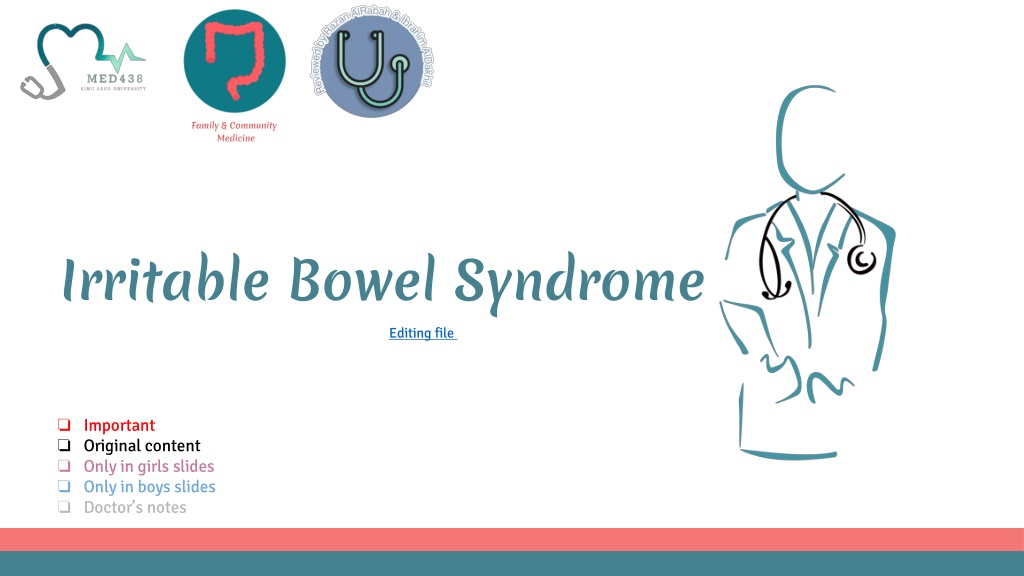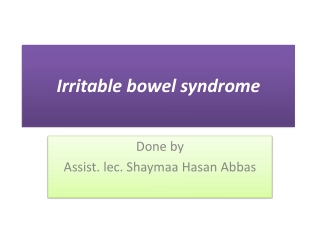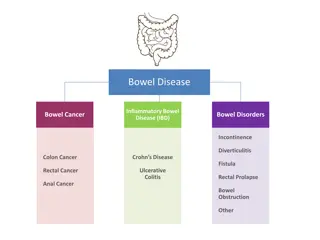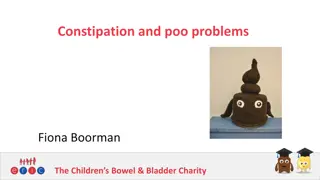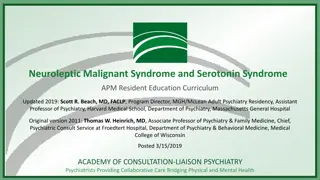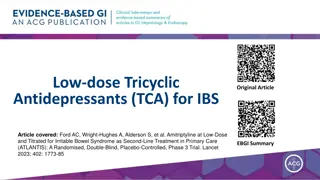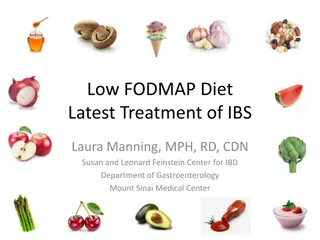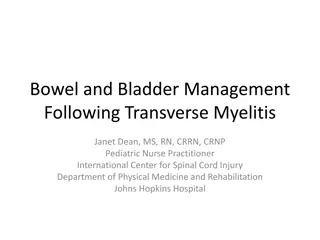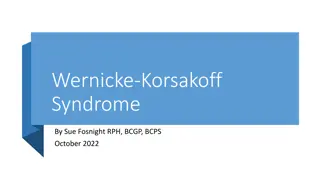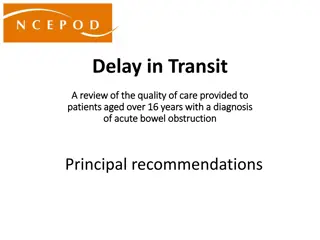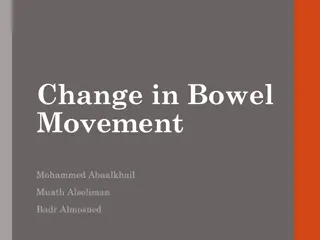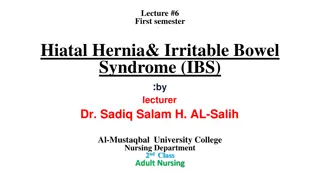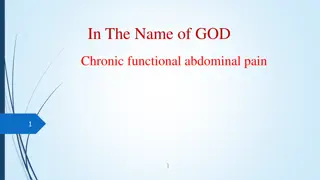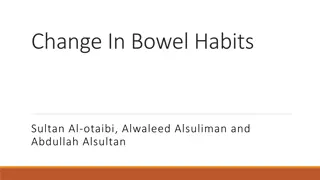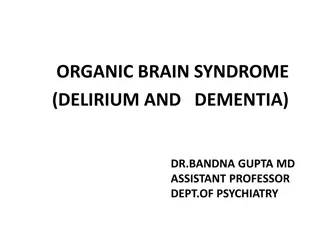Understanding Irritable Bowel Syndrome: Pathophysiology, Symptoms, and Management
Irritable Bowel Syndrome (IBS) is a common gastrointestinal condition with uncertain pathophysiology involving factors like motility, hypersensitivity, inflammation, and gut microflora. Symptoms include abdominal pain, altered bowel habits, and bloating. Diagnosis is based on Rome IV criteria, and management strategies include dietary changes, psychological support, and addressing food sensitivities.
Download Presentation

Please find below an Image/Link to download the presentation.
The content on the website is provided AS IS for your information and personal use only. It may not be sold, licensed, or shared on other websites without obtaining consent from the author. Download presentation by click this link. If you encounter any issues during the download, it is possible that the publisher has removed the file from their server.
E N D
Presentation Transcript
Family & Community Medicine Irritable Bowel Syndrome Editing file Important Original content Only in girls slides Only in boys slides Doctor s notes
OBJECTIVES: 01 Understand the hypothesis & explain the pathophysiology of IBS . 02 Common sign & symptoms . 03 Rome IV criteria of diagnosis . 04 IBS management .
Irritable Bowel Syndrome (IBS): deretla dna niap lanimodba cinorhc yb deziretcarahc redrosid lanitsetniortsag a si .esuac cinagro yna fo ecnesba eht ni stibah lewob * It is the most commonly diagnosed gastrointestinal condition* Pathophysiology: *It remains uncertain, yet it is viewed as a disorder resulting from an interaction among a number of factors*. 2 1 3 Gastrointestinal Motility Visceral Hypersensitivity *increased sensation in response to stimuli* Intestinal Inflammation - Numbers of lymphocytes have been reported in the colon and small intestine in patients with IBS . - In lymphocyte infiltration in the myenteric plexus in 9 patients and neuron degeneration in 6 patients . -These cells release mediators (nitric oxide, histamine and proteases) capable of stimulating the ENS, leading to abnormal motor and visceral responses within the intestine. Motor abnormalities of the GI tract are detectable in some patients with IBS edulcni devresbo seitilamronbA : Is a frequent finding in IBS patients. Perception in the gastrointestinal (GI) tract results from stimulation of various receptors in the gut wall . -Increased frequency and irregularity of luminal contractions . -Prolonged transit time in constipation- predominant IBS. These receptors transmit signals via afferent neural pathways to the dorsal horn of the spinal cord and ultimately to the brain. -If the Motility is slow Constipation (Mainly on the left side. Overcome by high fiber intake/laxatives). -If the Motility is Fast Diarrhea. 1 1
5 Alteration in Fecal Microflora 4 6 Food Hypersensitivity Psychological Dysfunction -Change in gut microbiota: emerging data suggest that the fecal microbiota in individuals with IBS differ from healthy controls and varies with the predominant symptom. Psychosocial factors may influence the expression of IBS. 7 Some food helps aggravate/worsen the case, so most patients use a gluten-free diet which helped them out a lot, remain not understood. Postinfectious: E.coli -Bacterial Overgrowth. Distention: eht ni noitnetsid noollab yb desuac niap dna ssenerawa ,SBI htiw stneitap ni taht nwohs evah seiduts suoiraV slortnoc htiw derapmoc semulov noollab rewol ta decneirepxe era enitsetni . Bloating( SBI htiw stneitap fo flah tuobA :mainly those with constipation htrig lanimodba ni esaercni elbarusaem a evah ) ( gnitaolb htiw detaicossasensation of abdominal fullness ) . It is unclear whether heightened sensitivity of the intestines to normal sensations is mediated by the local GI nervous system, by central modulation from the brain, or by some combination of the two. 1 2
Clinical feature: - Younger patients and women are more likely to be diagnosed with IBS. - 2:1female predominance in North America though. - In china males are more common to have IBS . Signs & Symptoms mnemonics: *Camila Ate Donuts with Cranberries* Chronic abdominal pain Altered bowel habits Diarrhea Other gastrointestinal symptoms Constipation GERD, dysphagia, early satiety, intermittent dyspepsia, nausea, and non-cardiac chest pain . 1 3
Diagnostic Criteria (Rome III) Recurrent abdominal pain on average at least 3 day/month in the last 3 months, associated with two or more of the following criteria: 2 1 3 Associated with a change in frequency of stool . Associated with a change in form (appearance) of stool. Improvement with defecation . Diagnostic Criteria (Rome IV) MOST recent & Important criteria than rome III Recurrent abdominal pain on average at least 1 day/week in the last 3 months, associated with two or more of the following criteria: 2 Criteria fulfilled for the last 3 months with symptom onset at least 6 months before diagnosis. 1 3 Associated with a change in frequency of stool . Associated with a change in form (appearance) of stool. Related to defecation . 1 4
IBS Subtypes *Managed by fibers/laxatives* *Managed by Imodium(loperamide)* IBS with constipation Hard or lumpy stools Loose or watery stools <25%of bowel movements . IBS with diarrhea Loose or watery stools 25% Hard or lumpy stools <25%of bowel movements . Mixed IBS Unsubtyped IBS Insufficient abnormality of stool consistency to meet the above subtypes . 25% Hard or lumpy stools Loose or watery stools 25% of bowel movements . 25% 1 2 3 4 Diagnostic Approach Management Patients are identified as having a symptom complex compatible with IBS based upon the Rome III criteria . Routine laboratory studies (CBC, chemistries) are normal in IBS. IBS is a chronic condition with no known cure. The focus of treatment should be on relief of symptoms ni dna addressing the patient's concerns. - - - - - - Therapeutic relationship . Patient education . Dietary modification . Psychosocial therapies . Antidepressants (eg. SSRI). Symptomatic relief of pain . NO RED FLAGS SYMPTOMS (Age > 40 - Rectal bleeding . - Nocturnal or progressive abdominal pain . - Weight loss. (>10%in 6 months) - Anemia. ) : *We don t worry about Rome criteria* 1 5
QUIZ! 1 3 Increased numbers of which one of the following cells have been reported in the colon and small intestine in patients with IBS: Macrophages. Monocytes. Lymphocytes. Neutrophils. Which one of the following is the most commonly diagnosed gastrointestinal condition: IBD. IBS. Colitis. Pancreatitis. A) B) C) D) A) B) C) D) 2 4 Which CRITERIA is the recent criteria that is used in diagnosis of IBS : Rome criteria I. Rome criteria II. Rome criteria III. Rome criteria IV. Which one of the following used to manage the symptoms for a patient with IBS: Dietary modification. Antidepressant medications. Psychosocial therapies. All of the above. A) B) C) D) A) B) C) D) Answers: D ) ,C) 4 ,D ) 3 ,B ) 2 1
THIS WORK IS DONE BY: Abdulrahman Bedaiwi ibiatO lA eduJ - & Give us your feedback!
